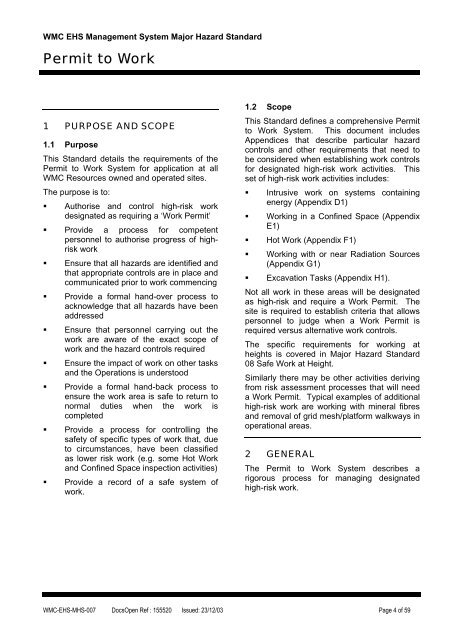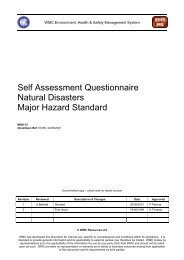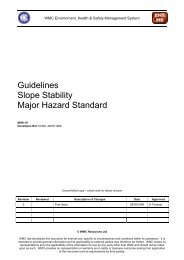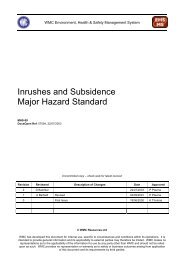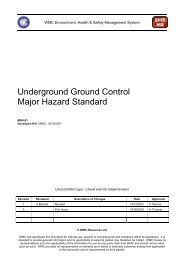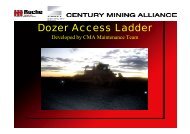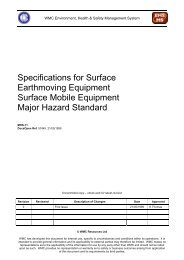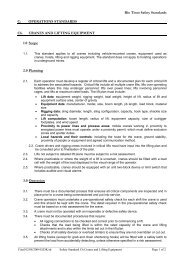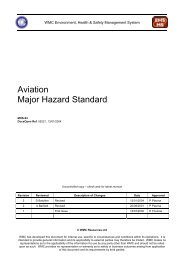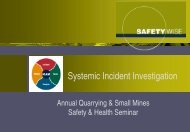Permit to Work Major Hazard Standard - MIRMgate
Permit to Work Major Hazard Standard - MIRMgate
Permit to Work Major Hazard Standard - MIRMgate
You also want an ePaper? Increase the reach of your titles
YUMPU automatically turns print PDFs into web optimized ePapers that Google loves.
WMC EHS Management System <strong>Major</strong> <strong>Hazard</strong> <strong>Standard</strong><br />
<strong>Permit</strong> <strong>to</strong> <strong>Work</strong><br />
1 PURPOSE AND SCOPE<br />
1.1 Purpose<br />
This <strong>Standard</strong> details the requirements of the<br />
<strong>Permit</strong> <strong>to</strong> <strong>Work</strong> System for application at all<br />
WMC Resources owned and operated sites.<br />
The purpose is <strong>to</strong>:<br />
• Authorise and control high-risk work<br />
designated as requiring a ‘<strong>Work</strong> <strong>Permit</strong>’<br />
• Provide a process for competent<br />
personnel <strong>to</strong> authorise progress of highrisk<br />
work<br />
• Ensure that all hazards are identified and<br />
that appropriate controls are in place and<br />
communicated prior <strong>to</strong> work commencing<br />
• Provide a formal hand-over process <strong>to</strong><br />
acknowledge that all hazards have been<br />
addressed<br />
• Ensure that personnel carrying out the<br />
work are aware of the exact scope of<br />
work and the hazard controls required<br />
• Ensure the impact of work on other tasks<br />
and the Operations is unders<strong>to</strong>od<br />
• Provide a formal hand-back process <strong>to</strong><br />
ensure the work area is safe <strong>to</strong> return <strong>to</strong><br />
normal duties when the work is<br />
completed<br />
• Provide a process for controlling the<br />
safety of specific types of work that, due<br />
<strong>to</strong> circumstances, have been classified<br />
as lower risk work (e.g. some Hot <strong>Work</strong><br />
and Confined Space inspection activities)<br />
• Provide a record of a safe system of<br />
work.<br />
1.2 Scope<br />
This <strong>Standard</strong> defines a comprehensive <strong>Permit</strong><br />
<strong>to</strong> <strong>Work</strong> System. This document includes<br />
Appendices that describe particular hazard<br />
controls and other requirements that need <strong>to</strong><br />
be considered when establishing work controls<br />
for designated high-risk work activities. This<br />
set of high-risk work activities includes:<br />
• Intrusive work on systems containing<br />
energy (Appendix D1)<br />
• <strong>Work</strong>ing in a Confined Space (Appendix<br />
E1)<br />
• Hot <strong>Work</strong> (Appendix F1)<br />
• <strong>Work</strong>ing with or near Radiation Sources<br />
(Appendix G1)<br />
• Excavation Tasks (Appendix H1).<br />
Not all work in these areas will be designated<br />
as high-risk and require a <strong>Work</strong> <strong>Permit</strong>. The<br />
site is required <strong>to</strong> establish criteria that allows<br />
personnel <strong>to</strong> judge when a <strong>Work</strong> <strong>Permit</strong> is<br />
required versus alternative work controls.<br />
The specific requirements for working at<br />
heights is covered in <strong>Major</strong> <strong>Hazard</strong> <strong>Standard</strong><br />
08 Safe <strong>Work</strong> at Height.<br />
Similarly there may be other activities deriving<br />
from risk assessment processes that will need<br />
a <strong>Work</strong> <strong>Permit</strong>. Typical examples of additional<br />
high-risk work are working with mineral fibres<br />
and removal of grid mesh/platform walkways in<br />
operational areas.<br />
2 GENERAL<br />
The <strong>Permit</strong> <strong>to</strong> <strong>Work</strong> System describes a<br />
rigorous process for managing designated<br />
high-risk work.<br />
WMC-EHS-MHS-007 DocsOpen Ref : 155520 Issued: 23/12/03 Page 4 of 59


